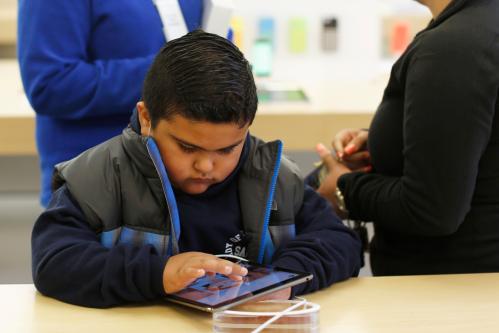Humans need humans. Anyone who has changed a plane ticket with an automated phone teller, or plodded through a digital pharmacy order is sympathetic to this fact. If only a human were on the other side of that receiver—how much easier would it be to get that ticket or that prescription? In an increasingly digital world, this seemingly mundane point about the role of humans in our lives becomes profound.
The scientific literature is clear. Humans are born into a socio-cultural world with (hopefully) socially sensitive adults who offer information that flows through a socially gated brain. Humans do not even learn the building blocks of reading or mathematics in isolation. These skills emerge in the context of early adult child interactions that feed communication skills. For example, a child learning to read does need decoding skills. Even if they sound out a word perfectly, however, they will not comprehend it if it’s not in their mental dictionary. Children cannot gather meaning from printed text without background knowledge and a rich language base. Thus, a number of scholars urge practitioners to teach reading by enriching language learning. And language learning is itself rooted in early social interactions. Social interactions are the currency of our species. As Michael Tomasello of Duke University argues, we are the ultra-human species.
But the ultra-social animal has come face to face with the non-social technology that seems to replace any need for human interaction. Since the introduction of modern smartphones in 2007 and digital tablets in 2010, we have dramatically changed our digital footprint. By 2017, children 2- to 8-years-old were using screen media for almost 3 hours a day, including 1 hour with mobile devices, the older crowd of teens are clocking in at about 9 hours per day. With only about 7-10 discretionary waking hours per day, these numbers represent a staggering entrance of technology into the daily activities of children. Our children are plugged-in, leaving little time for face-to-face interactions.
The introduction of technology is not the problem. For generations children grew with new inventions like radios and televisions. And with each new wave of technology, people worried about sacrifices that might indelibly challenge the way we interpret our humanness. What is uniquely different this time, however, is that these devices seriously crowd out opportunities for critical social interaction.
Two studies on parent-child play with digital and non-digital features make this point. In one by Anna Sosa, of Northern Arizona University, 10- to 16-month-olds played with parents using either e-toys or traditional toys like a wooden animal puzzle. In the e-toy condition, parents said fewer words and responded to the child less than in the traditional toy condition. Jennifer Zosh, of Penn State University, and colleagues, comparing digital and traditional toy sorters, witnessed a similar pattern. For the participating two-year-olds and parents, the digital context thwarted social interactions. And again, children heard fewer words in the digital than in the analog condition. Parental language was also more restricted and more behaviorally controlling in the digital condition of an e-book study that we ran in our laboratory in the pre-tablet era.
This early eclipsing of social input also appears in middle school. In clever research by Yalda Uhls and Patricia Greenfield of UCLA and colleagues, two classes of middle schoolers took tests designed to examine their social acumen—the Faces test in which children assess emotions of happy, sad, angry, and fearful faces and a test of social perception where children are asked to interpret the emotional states of adolescents in a variety of filmed social interactions. Children in both classes had equivalent social shrewdness at the beginning of the study. Then one class went on a five-day “nature” retreat without digital devices. Upon their return, they looked superior to their classmates on both tests. These findings suggest that human interaction made the critical difference.
Further, researchers from the Knowledge Matters Campaign noticed that schools that are defined as knowledge rich share one common characteristic—they have built strong learning communities that are at base—social.
And a study being undertaken within the Department of Education in the Philippines showed that digital technology might not make up for the lack of social interaction. This work explores similarities across students’ performance as they collaborate in a digital environment versus face-to-face. The students are charged with completing essentially the same tasks through very different media. The range of full body behaviors observed in the face-to-face classroom context explodes earlier beliefs that we can capture the richness of collaborative behavior through online facilities.
The occasional expression or chuckle from students as they engage in online written “chat” is revealed as a very limited sampling of the cognitive and social processes. The online environment provides only a restricted medium through which students engage in a task via click drag and drop actions, and communicate with an online partner via typed input with each such behavior occurring in isolation of the other. In contrast, students working face-to-face are drawing on a wider range of capabilities through interaction with multiple partners, while simultaneously engaging in set tasks. As can be seen from the photographs, students are focused in both media, but their engagement is qualitatively richer in the real life setting.


There is much that we do not yet know about the changing nature of social interaction spurred by the digital revolution. Hints from the psychological literature and the classroom suggest that children might be our canaries in the coal mines.
We are entering a period where digital technology is crowding out opportunities for high-quality social interaction. Advances in technologies that allow us to work on the go, travel safely in unknown territories, and stay socially connected, have coincided with a connectedness to devices that paradoxically divide our attention between face-to-face social interactions and screens.
Even our educational systems are moving towards individualized and targeted instruction from digital tutors who augment what teachers provide—but without the teachers. Cries to not let technology crowd out teaching or replace it, but rather to augment it, are booming. As Dale Johnson from Arizona State University thinks of it, the best results for learning will come from High Touch and High Tech environments where tech helps children remember and understand, leaving the ability to transfer, analyze, evaluate, and create to the high-touch humans. In fact, the former education minister of South Korea, Ju-Ho Lee, argues that this philosophy has helped catapult South Korean students to the top of the international testing charts. Humans 1, Robots 0.
Perhaps it is time to assert balance between our obsession with digital platforms and real face-to-face human interaction. In a 21st century world—a world in which working in teams across global divides will be ever more important, children will need to exercise the social skills that prepare them for learning, for modern day work, for an unknown future and prepare them to be participating citizens. Digital platforms are a part of our everyday but they must serve humans rather than compromise our natural social instincts. As Alex Beard writes in his new book, Natural Born Learners,
“And if the robots do take the jobs, it’s our human qualities that will count…The greatest impact of technology on learning may paradoxically be to push us towards the human (p. 306).”
The Brookings Institution is committed to quality, independence, and impact.
We are supported by a diverse array of funders. In line with our values and policies, each Brookings publication represents the sole views of its author(s).










Commentary
The New Humanism: Technology should enhance, not replace, human interactions
June 11, 2018